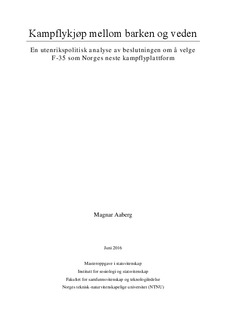Kamflykjøp mellom barken og veden : en utenrikspolitisk analyse av beslutningen om å velge F-35 som Norges neste kampflyplattform
Master thesis
Permanent lenke
http://hdl.handle.net/11250/2419669Utgivelsesdato
2016Metadata
Vis full innførselSamlinger
Sammendrag
This thesis explores the space for political manoeuvring available to the Norwegian government in their decision to procure the American fighter jet F-35 Joint Strike Fighter in 2008. Specifically, the thesis seeks to explain why the Norwegian government chose the F-35, and concentrates on (i) the process leading to the Ministry of Defence’s (FD) recommendation of the F-35, and on (ii) the political decision to purchase the F-35. It does so by applying a Foreign Policy Analysis to show how the decision was influenced both by “outside-in”- and “inside-out”-factors. Four hypotheses are developed from (i) structural realist theory on alliance dynamics, (ii) liberal IR-theory in combination with theories of international bargaining, (iii) commercial liberalism and theories on industrial influence, and finally (iv) Allison’s bureaucratic politics model is combined with theories on civil-military relations and pathdependency. The hypotheses are tested by using a process-tracing method, but only the first two hypotheses find sufficient support in the empirical analysis. The study concludes that the purchase of F-35 seems best to be explained by “outside-in”-factors, namely alliance politics. However, governmental political interests first seemed to exclude the F-35 from the list of available options. Thus the Norwegian decision to purchase a new fighter jet was placed between a rock and a hard place. Through skilful political engineering, and by disguising the motives concerning alliance and security politics with a veil of motives concerning price, technical quality, and industrial benefits, the space opened up to allow the purchase of the F-35. This study also indicates that this strategy also hardened the contest between the suppliers, especially concerning industrial benefits, but these considerations were not decisive for the selection of the F-35. The study also indicates that the Norwegian government organized the decision making process in a way that both depoliticised the process and limited the influence of presumed biased forces in the bureaucracy and military expertise.
